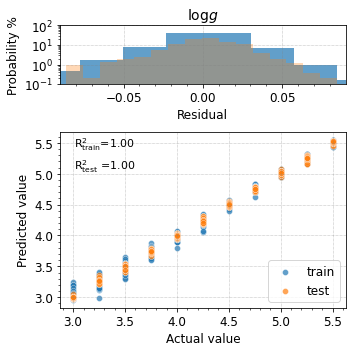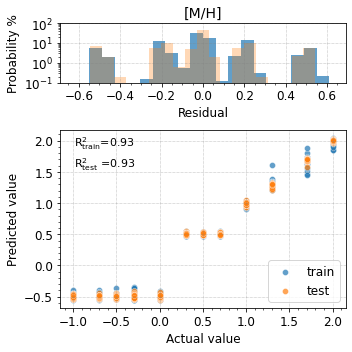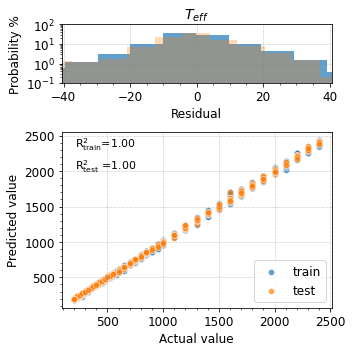4. Train ConvNN Model: Regression Method¶
In the following steps, you will:
Load the brown dwarf dataset used to train the ML models.
Prepare the X and y variables to deploy the trained ML models.
Visualize them for a few cases.
We will need the following modules from TelescopeML:
DeepBuilder: to prepare the synthetic brown dwarf dataset and load the trained machine learning (ML) models.
Predictor: to prepare the observational brown dwarf dataset and deploy the trained ML models.
StatVisAnalyzer: to provide statistical tests and plotting functions.
IO_utils: to provide functions to load the trained ML models.
[1]:
from TelescopeML.DataMaster import *
from TelescopeML.DeepTrainer import *
from TelescopeML.Predictor import *
from TelescopeML.IO_utils import load_or_dump_trained_model_CNN
from TelescopeML.StatVisAnalyzer import *
No Bottleneck unit testing available.
3.1 Data Preperation¶
3.1.1 Load the Synthetic spectra - training dataset¶
We computed a low-resolution spectrum (\(R\)=200) utilizing atmopshric brown dwarfs grid model, Sonora-Bobcat for spectral range $:nbsphinx-math:sim`$0.9-2.4 :math:mu m`. An open-source atmospheric radiative transfer Python package, PICASO was employed for generating these datasets. This dataset encompass 30,888 synthetic spectra (or instances or rows).
Each spectrum has 104 wavelengths (i.e., 0.897, 0.906, …, 2.512 μm) and 4 output atmospheric parameters:
gravity (log g)
temperature (Teff)
carbon-to-oxygen ratio (C/O)
metallicity ([M/H])
[2]:
import os
__reference_data_path__ = os.getenv("TelescopeML_reference_data")
__reference_data_path__
# Note: insert the directory of the reference_data if you get an error reading the reference data!!!
# __reference_data_path__ = 'INSERT_DIRECTORY_OF_reference_data'
[2]:
'/Users/egharibn/RESEARCH/ml/projects/TelescopeML_project/reference_data/'
Load the dataset and check few instances
[3]:
train_BD = pd.read_csv(os.path.join(__reference_data_path__,
'training_datasets',
'browndwarf_R100_v4_newWL_v3.csv.bz2'), compression='bz2')
train_BD.head()
[3]:
| gravity | temperature | c_o_ratio | metallicity | 2.512 | 2.487 | 2.462 | 2.438 | 2.413 | 2.389 | ... | 0.981 | 0.971 | 0.962 | 0.952 | 0.943 | 0.933 | 0.924 | 0.915 | 0.906 | 0.897 | |
|---|---|---|---|---|---|---|---|---|---|---|---|---|---|---|---|---|---|---|---|---|---|
| 0 | 5.0 | 1100 | 0.25 | -1.0 | 9.103045e-08 | 1.181658e-07 | 1.307868e-07 | 1.269229e-07 | 1.159179e-07 | 8.925110e-08 | ... | 1.257751e-07 | 9.640859e-08 | 7.612550e-08 | 6.901364e-08 | 6.247359e-08 | 4.112384e-08 | 5.127995e-08 | 4.897355e-08 | 4.087795e-08 | 2.791689e-08 |
| 1 | 5.0 | 1100 | 0.25 | -0.7 | 9.103045e-08 | 1.181658e-07 | 1.307868e-07 | 1.269229e-07 | 1.159179e-07 | 8.925110e-08 | ... | 1.257751e-07 | 9.640859e-08 | 7.612550e-08 | 6.901364e-08 | 6.247359e-08 | 4.112384e-08 | 5.127995e-08 | 4.897355e-08 | 4.087795e-08 | 2.791689e-08 |
| 2 | 5.0 | 1100 | 0.25 | -0.5 | 9.103045e-08 | 1.181658e-07 | 1.307868e-07 | 1.269229e-07 | 1.159179e-07 | 8.925110e-08 | ... | 1.257751e-07 | 9.640859e-08 | 7.612550e-08 | 6.901364e-08 | 6.247359e-08 | 4.112384e-08 | 5.127995e-08 | 4.897355e-08 | 4.087795e-08 | 2.791689e-08 |
| 3 | 5.0 | 1100 | 0.25 | -0.3 | 9.103045e-08 | 1.181658e-07 | 1.307868e-07 | 1.269229e-07 | 1.159179e-07 | 8.925110e-08 | ... | 1.257751e-07 | 9.640859e-08 | 7.612550e-08 | 6.901364e-08 | 6.247359e-08 | 4.112384e-08 | 5.127995e-08 | 4.897355e-08 | 4.087795e-08 | 2.791689e-08 |
| 4 | 5.0 | 1100 | 0.25 | 0.0 | 9.103045e-08 | 1.181658e-07 | 1.307868e-07 | 1.269229e-07 | 1.159179e-07 | 8.925110e-08 | ... | 1.257751e-07 | 9.640859e-08 | 7.612550e-08 | 6.901364e-08 | 6.247359e-08 | 4.112384e-08 | 5.127995e-08 | 4.897355e-08 | 4.087795e-08 | 2.791689e-08 |
5 rows × 108 columns
3.1.2 Check atmospheric parameters¶
gravity (log g)
temperature (Teff)
carbon-to-oxygen ratio (C/O)
metallicity ([M/H])
[4]:
output_names = ['gravity', 'temperature', 'c_o_ratio', 'metallicity']
train_BD[output_names].head()
[4]:
| gravity | temperature | c_o_ratio | metallicity | |
|---|---|---|---|---|
| 0 | 5.0 | 1100 | 0.25 | -1.0 |
| 1 | 5.0 | 1100 | 0.25 | -0.7 |
| 2 | 5.0 | 1100 | 0.25 | -0.5 |
| 3 | 5.0 | 1100 | 0.25 | -0.3 |
| 4 | 5.0 | 1100 | 0.25 | 0.0 |
[5]:
wavelength_names = [item for item in train_BD.columns.to_list() if item not in output_names]
wavelength_names[:5]
[5]:
['2.512', '2.487', '2.462', '2.438', '2.413']
[6]:
wavelength_values = [float(item) for item in wavelength_names]
wavelength_values[:10]
[6]:
[2.512, 2.487, 2.462, 2.438, 2.413, 2.389, 2.366, 2.342, 2.319, 2.296]
[7]:
wl_synthetic = pd.read_csv(os.path.join(__reference_data_path__,
'training_datasets',
'wl.csv'))
wl_synthetic.head()
[7]:
| wl | |
|---|---|
| 0 | 2.511960 |
| 1 | 2.486966 |
| 2 | 2.462220 |
| 3 | 2.437720 |
| 4 | 2.413464 |
3.1.3 Prepare Inputs and outputs for ML models (X,y)¶
X: 104 wavelengths and their corresponding flux values
y: output variables: ‘gravity’, ‘temperature’, ‘c_o_ratio’, ‘metallicity’
[8]:
# Training variables
X = train_BD.drop(
columns=['gravity',
'temperature',
'c_o_ratio',
'metallicity'])
# Target/Output feature variables
y = train_BD[['gravity', 'c_o_ratio', 'metallicity', 'temperature', ]]
log-transform the ‘temperature’ variable toreduce the skewness of the data, making it more symmetric and normal-like for the ML model
[9]:
y.loc[:, 'temperature'] = np.log10(y['temperature'])
[10]:
# check the output variables
y.head()
[10]:
| gravity | c_o_ratio | metallicity | temperature | |
|---|---|---|---|---|
| 0 | 5.0 | 0.25 | -1.0 | 3.041393 |
| 1 | 5.0 | 0.25 | -0.7 | 3.041393 |
| 2 | 5.0 | 0.25 | -0.5 | 3.041393 |
| 3 | 5.0 | 0.25 | -0.3 | 3.041393 |
| 4 | 5.0 | 0.25 | 0.0 | 3.041393 |
3.2 Build the CNN model and Processing the Data¶
Here we instintiate BuildRegressorCNN class from DeepBuilder module to prepare the datasets and take the trained CNN (Convolutional Neural Networks) for us:
Take the synthetic datasets
Process them, e.g.
Divide them to three sets: train, validation, and test sets
Scale y variables
Scale X variables
Create new features
3.2.1 Instintiate BuildRegressorCNN class from DeepBuilder module¶
[11]:
data_processor = DataProcessor(
flux_values=X.to_numpy(),
wavelength_names=X.columns,
wavelength_values=wavelength_values,
output_values=y.to_numpy(),
output_names=output_names,
spectral_resolution=200,
trained_ML_model=None,
trained_ML_model_name='CNN',
)
3.2.2 Split the dataset into train, validate and test sets¶
[12]:
data_processor.split_train_validation_test(test_size=0.1,
val_size=0.1,
random_state_=42,)
3.2.3 Standardize X Variables Row-wise¶
[13]:
# Scale the X features using MinMax Scaler
data_processor.standardize_X_row_wise()
[14]:
plot_boxplot(
data = data_processor.X_train_standardized_rowwise[:, ::-1],
title='Scaled main 104 Features',
xlabel='Wavelength [$\mu$m]',
ylabel='Scaled Values',
xticks_list=wavelength_names[::-1],
fig_size=(18, 5),
saved_file_name = 'Scaled_input_fluxes',
__reference_data__ = __reference_data_path__,
__save_plots__=True
)

3.2.4 Standardize y Variables Column-wise¶
[15]:
# Standardize the y features using Standard Scaler
data_processor.standardize_y_column_wise()
[16]:
plot_boxplot(
data = data_processor.y_train_standardized_columnwise,
title='Scaled main 104 Features',
xlabel='Wavelength',
ylabel='Scaled Output Values',
xticks_list=['','$\log g$', 'T$_{eff}$', 'C/O ratio', '[M/H]'],
fig_size=(5, 5),
saved_file_name = 'Scaled_output_parameters',
__reference_data__ = __reference_data_path__,
__save_plots__=True
)
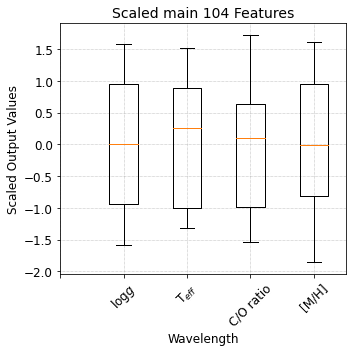
3.2.5 Feature engeenering: Take Min and Max of each row (BD spectra)¶
[17]:
# train
data_processor.X_train_min = data_processor.X_train.min(axis=1)
data_processor.X_train_max = data_processor.X_train.max(axis=1)
# validation
data_processor.X_val_min = data_processor.X_val.min(axis=1)
data_processor.X_val_max = data_processor.X_val.max(axis=1)
# test
data_processor.X_test_min = data_processor.X_test.min(axis=1)
data_processor.X_test_max = data_processor.X_test.max(axis=1)
[18]:
df_MinMax_train = pd.DataFrame((data_processor.X_train_min, data_processor.X_train_max)).T
df_MinMax_val = pd.DataFrame((data_processor.X_val_min, data_processor.X_val_max)).T
df_MinMax_test = pd.DataFrame((data_processor.X_test_min, data_processor.X_test_max)).T
[19]:
df_MinMax_train.rename(columns={0:'min', 1:'max'}, inplace=True)
df_MinMax_val.rename(columns={0:'min', 1:'max'}, inplace=True)
df_MinMax_test.rename(columns={0:'min', 1:'max'}, inplace=True)
[20]:
df_MinMax_train.head()
[20]:
| min | max | |
|---|---|---|
| 0 | 8.265340e-12 | 3.445259e-08 |
| 1 | 8.080712e-22 | 8.397132e-14 |
| 2 | 2.734403e-07 | 8.632182e-06 |
| 3 | 4.414951e-16 | 3.373262e-10 |
| 4 | 3.722576e-07 | 6.859888e-06 |
3.2.6 Scale Min Max features - ColumnWise¶
[21]:
data_processor.standardize_X_column_wise(
output_indicator='Trained_StandardScaler_X_ColWise_MinMax',
X_train = df_MinMax_train.to_numpy(),
X_val = df_MinMax_val.to_numpy(),
X_test = df_MinMax_test.to_numpy(),
)
[22]:
plot_boxplot(
data = data_processor.X_test_standardized_columnwise,
title='Scaled Min Max Inputs - ColumnWise',
xlabel='Wavelength',
ylabel='Scaled Output Values',
xticks_list= ['','Min','Max'],
fig_size=(5, 5),
saved_file_name = 'Scaled_input_Min_Max_fluxes',
__reference_data__ = __reference_data_path__,
__save_plots__=True
)
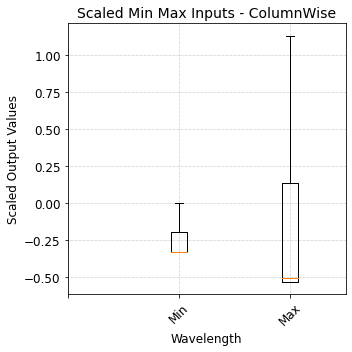
3.3 Train CNN model¶
3.3.1 Instintiate TrainRegressorCNN class from DeepTrainer Module¶
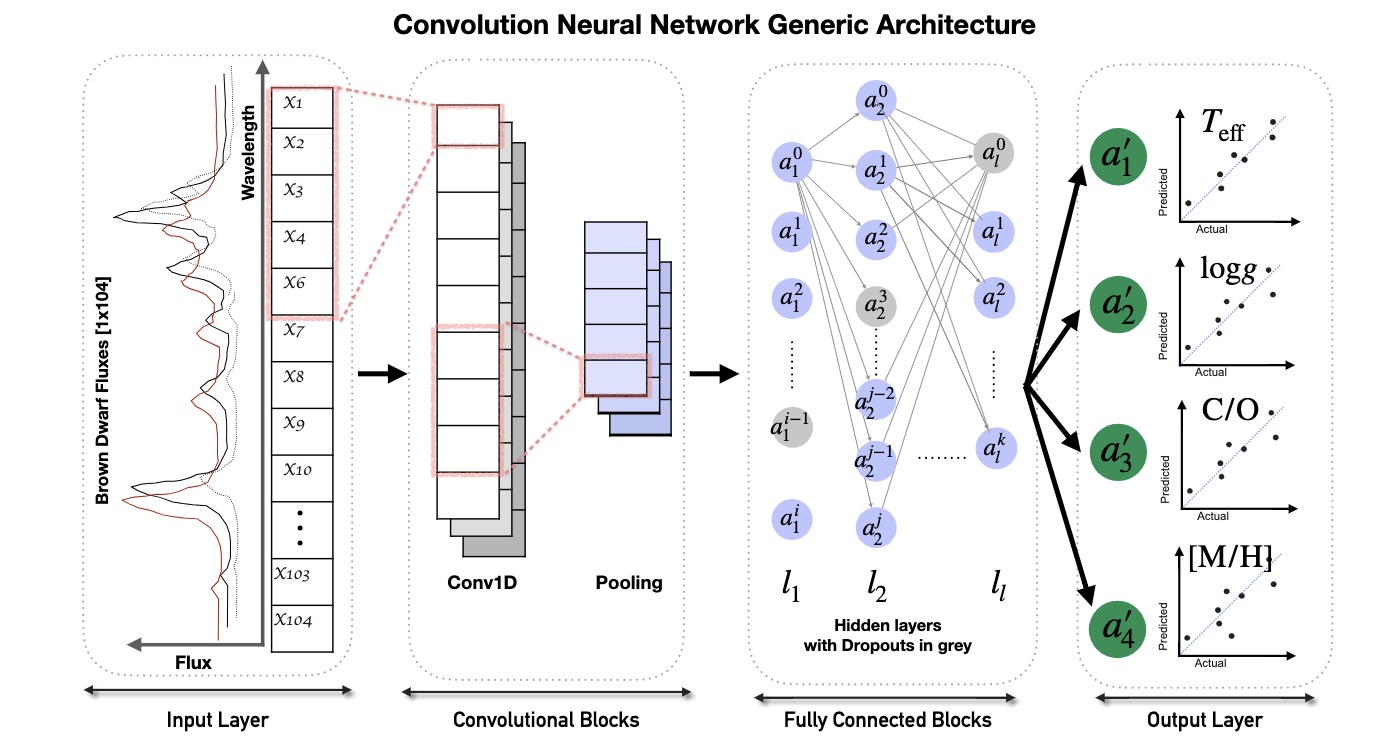
[23]:
train_cnn_model = TrainRegressorCNN(
# input dataset: StandardScaled instances
X1_train = data_processor.X_train_standardized_rowwise,
X1_val = data_processor.X_val_standardized_rowwise,
X1_test = data_processor.X_test_standardized_rowwise,
# input dataset: Min Max of each instance
X2_train = data_processor.X_train_standardized_columnwise,
X2_val = data_processor.X_val_standardized_columnwise,
X2_test = data_processor.X_test_standardized_columnwise,
# 1st target
y1_train = data_processor.y_train_standardized_columnwise[:,0],
y1_val = data_processor.y_val_standardized_columnwise[:,0],
y1_test = data_processor.y_test_standardized_columnwise[:,0],
# 2nd target
y2_train = data_processor.y_train_standardized_columnwise[:,1],
y2_val = data_processor.y_val_standardized_columnwise[:,1],
y2_test = data_processor.y_test_standardized_columnwise[:,1],
# 3rd target
y3_train = data_processor.y_train_standardized_columnwise[:,2],
y3_val = data_processor.y_val_standardized_columnwise[:,2],
y3_test = data_processor.y_test_standardized_columnwise[:,2],
# 4th target
y4_train = data_processor.y_train_standardized_columnwise[:,3],
y4_val = data_processor.y_val_standardized_columnwise[:,3],
y4_test = data_processor.y_test_standardized_columnwise[:,3],
)
3.3.2 Define the Hyperparameters¶
[24]:
hyperparameters = {
'Conv__MaxPooling1D': 3,
'Conv__NumberBlocks': 2,
'Conv__NumberLayers': 3,
'Conv__filters': 32,
'Conv__kernel_size': 4,
'FC1__NumberLayers': 3,
'FC1__dropout': 0.0013358917126831819,
'FC1__units': 256,
'FC2__NumberBlocks': 1,
'FC2__NumberLayers': 4,
'FC2__dropout': 0.0018989744374361271,
'FC2__units': 128,
'lr': 0.00018890368162236508
}
3.3.3 Build a CNN model¶
[25]:
train_cnn_model.build_model(config=hyperparameters, )
Model: "model"
__________________________________________________________________________________________________
Layer (type) Output Shape Param # Connected to
==================================================================================================
input_1 (InputLayer) [(None, 104, 1)] 0 []
Conv__B1_L1 (Conv1D) (None, 104, 32) 160 ['input_1[0][0]']
Conv__B1_L2 (Conv1D) (None, 104, 128) 16512 ['Conv__B1_L1[0][0]']
Conv__B1_L3 (Conv1D) (None, 104, 288) 147744 ['Conv__B1_L2[0][0]']
Conv__B1__MaxPooling1D (Ma (None, 34, 288) 0 ['Conv__B1_L3[0][0]']
xPooling1D)
Conv__B2_L1 (Conv1D) (None, 34, 128) 147584 ['Conv__B1__MaxPooling1D[0][0]
']
Conv__B2_L2 (Conv1D) (None, 34, 288) 147744 ['Conv__B2_L1[0][0]']
Conv__B2_L3 (Conv1D) (None, 34, 512) 590336 ['Conv__B2_L2[0][0]']
Conv__B2__MaxPooling1D (Ma (None, 11, 512) 0 ['Conv__B2_L3[0][0]']
xPooling1D)
flatten (Flatten) (None, 5632) 0 ['Conv__B2__MaxPooling1D[0][0]
']
FC1__B1_L1 (Dense) (None, 256) 1442048 ['flatten[0][0]']
FC1__B1_L2 (Dense) (None, 1024) 263168 ['FC1__B1_L1[0][0]']
FC1__B1_L3 (Dense) (None, 2304) 2361600 ['FC1__B1_L2[0][0]']
FC1__B1_L3__Dropout (Dropo (None, 2304) 0 ['FC1__B1_L3[0][0]']
ut)
input_2 (InputLayer) [(None, 2)] 0 []
Concatenated_Layer (Concat (None, 2306) 0 ['FC1__B1_L3__Dropout[0][0]',
enate) 'input_2[0][0]']
FC2__B1_L1 (Dense) (None, 128) 295296 ['Concatenated_Layer[0][0]']
FC2__B1_L2 (Dense) (None, 512) 66048 ['FC2__B1_L1[0][0]']
FC2__B1_L3 (Dense) (None, 1152) 590976 ['FC2__B1_L2[0][0]']
FC2__B1_L4 (Dense) (None, 2048) 2361344 ['FC2__B1_L3[0][0]']
FC2__B1_L4__Dropout (Dropo (None, 2048) 0 ['FC2__B1_L4[0][0]']
ut)
output__gravity (Dense) (None, 1) 2049 ['FC2__B1_L4__Dropout[0][0]']
output__c_o_ratio (Dense) (None, 1) 2049 ['FC2__B1_L4__Dropout[0][0]']
output__metallicity (Dense (None, 1) 2049 ['FC2__B1_L4__Dropout[0][0]']
)
output__temperature (Dense (None, 1) 2049 ['FC2__B1_L4__Dropout[0][0]']
)
==================================================================================================
Total params: 8438756 (32.19 MB)
Trainable params: 8438756 (32.19 MB)
Non-trainable params: 0 (0.00 Byte)
__________________________________________________________________________________________________
None
3.3.4 Train the CNN model using the datasets¶
[26]:
history, model = train_cnn_model.fit_cnn_model(batch_size=1000,
budget=2)
Epoch 1/2
26/26 [==============================] - 32s 1s/step - loss: 2.0709 - output__gravity_loss: 0.8436 - output__c_o_ratio_loss: 0.4558 - output__metallicity_loss: 0.4111 - output__temperature_loss: 0.3604 - output__gravity_mae: 1.2371 - output__c_o_ratio_mae: 0.8332 - output__metallicity_mae: 0.7632 - output__temperature_mae: 0.6080 - val_loss: 0.7365 - val_output__gravity_loss: 0.3041 - val_output__c_o_ratio_loss: 0.2354 - val_output__metallicity_loss: 0.1756 - val_output__temperature_loss: 0.0214 - val_output__gravity_mae: 0.6611 - val_output__c_o_ratio_mae: 0.5466 - val_output__metallicity_mae: 0.4765 - val_output__temperature_mae: 0.1522
Epoch 2/2
26/26 [==============================] - 31s 1s/step - loss: 0.5539 - output__gravity_loss: 0.2413 - output__c_o_ratio_loss: 0.1425 - output__metallicity_loss: 0.1498 - output__temperature_loss: 0.0202 - output__gravity_mae: 0.5749 - output__c_o_ratio_mae: 0.4192 - output__metallicity_mae: 0.4384 - output__temperature_mae: 0.1561 - val_loss: 0.4836 - val_output__gravity_loss: 0.1971 - val_output__c_o_ratio_loss: 0.0843 - val_output__metallicity_loss: 0.1858 - val_output__temperature_loss: 0.0164 - val_output__gravity_mae: 0.5207 - val_output__c_o_ratio_mae: 0.3192 - val_output__metallicity_mae: 0.4981 - val_output__temperature_mae: 0.1421
3.3.5 Check the Trained CNN Archeticture and Summary¶
Checking the architecture of a CNN and its summary is importnat because it provide insights about: - Model Design and Structure - Model complexity - Hyperparameter Tuning:
[27]:
data_processor.trained_ML_model = model
data_processor.history = history
[28]:
tf.keras.utils.plot_model(
train_cnn_model.model,
to_file="model.png",
show_shapes=True,
show_dtype=False,
show_layer_names=True,
rankdir="TB",
expand_nested=True,
dpi=90,
layer_range=None,
)
[28]:

3.3.6 Trained Model Outcomes¶
Note: This is not the final trained model because the budget is very low and the batch number is very high. For this reason, we add “_TEST” to the end of the model name, but we will not be using it.
[29]:
load_or_dump_trained_model_CNN( trained_model = data_processor,
output_indicator='tuned_bohb_batch32_v3_1000epoch_out10_TEST',
load_or_dump = 'dump')
/usr/local/anaconda3/envs/dl2/lib/python3.9/site-packages/keras/src/engine/training.py:3079: UserWarning: You are saving your model as an HDF5 file via `model.save()`. This file format is considered legacy. We recommend using instead the native Keras format, e.g. `model.save('my_model.keras')`.
saving_api.save_model(
3.4 Check the performance of the Trained Model¶
3.4.1 Load the Saved Trained CNN Models¶
[30]:
loaded_model, history = load_or_dump_trained_model_CNN(output_indicator='tuned_bohb_batch32_v3_1000epoch_out10',
load_or_dump = 'load')
[31]:
train_cnn_model.trained_model = loaded_model
train_cnn_model.trained_model_history = history
3.4.2 Double-check the Trained CNN Archeticture and Summary¶
[32]:
tf.keras.utils.plot_model(
train_cnn_model.trained_model,
# to_file="model.png",
show_shapes=True,
show_dtype=False,
show_layer_names=True,
rankdir="TB",
expand_nested=True,
dpi=90,
layer_range=None,
)
[32]:
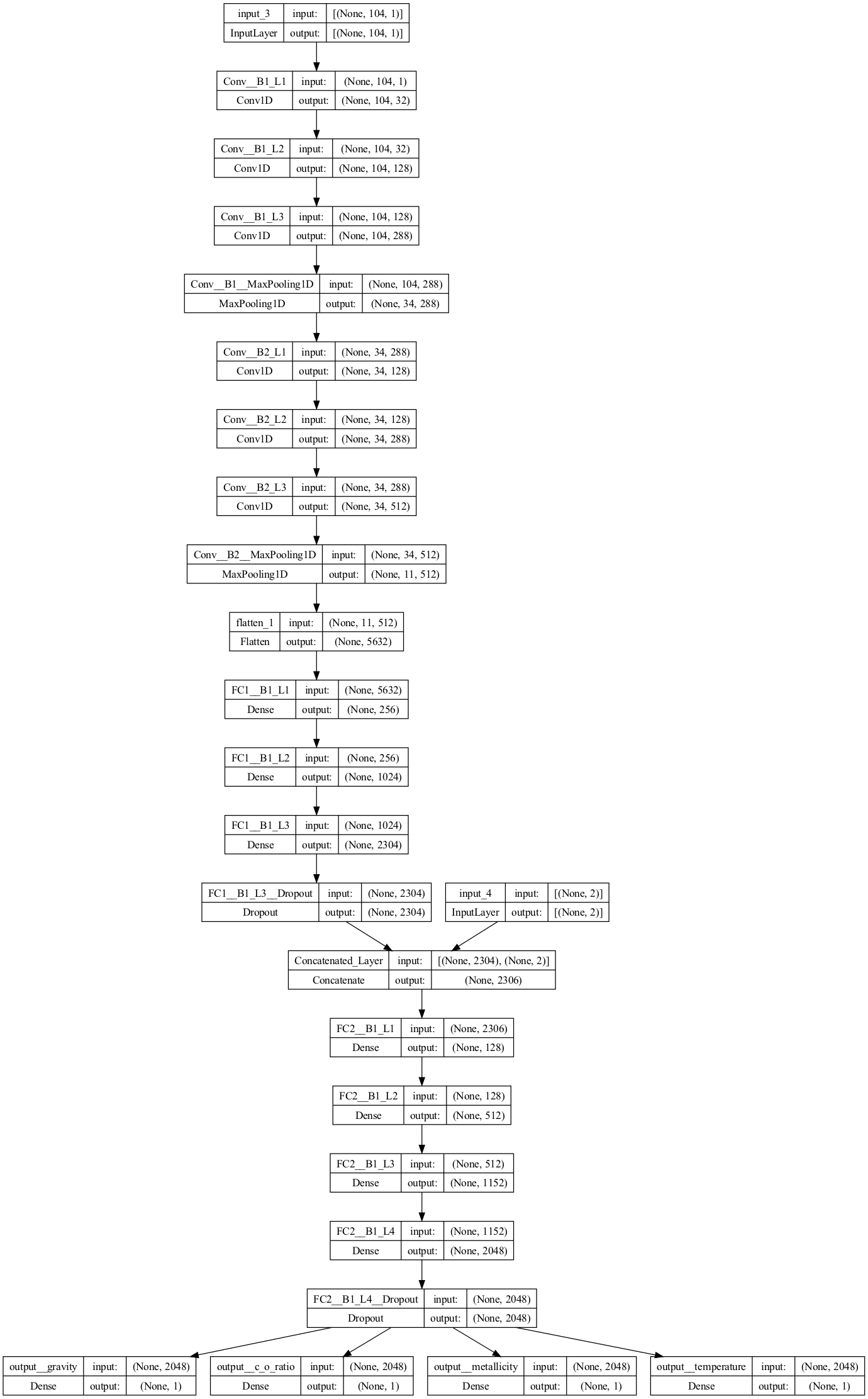
[33]:
train_cnn_model.trained_model.summary()
Model: "model_1"
__________________________________________________________________________________________________
Layer (type) Output Shape Param # Connected to
==================================================================================================
input_3 (InputLayer) [(None, 104, 1)] 0 []
Conv__B1_L1 (Conv1D) (None, 104, 32) 160 ['input_3[0][0]']
Conv__B1_L2 (Conv1D) (None, 104, 128) 16512 ['Conv__B1_L1[0][0]']
Conv__B1_L3 (Conv1D) (None, 104, 288) 147744 ['Conv__B1_L2[0][0]']
Conv__B1__MaxPooling1D (Ma (None, 34, 288) 0 ['Conv__B1_L3[0][0]']
xPooling1D)
Conv__B2_L1 (Conv1D) (None, 34, 128) 147584 ['Conv__B1__MaxPooling1D[0][0]
']
Conv__B2_L2 (Conv1D) (None, 34, 288) 147744 ['Conv__B2_L1[0][0]']
Conv__B2_L3 (Conv1D) (None, 34, 512) 590336 ['Conv__B2_L2[0][0]']
Conv__B2__MaxPooling1D (Ma (None, 11, 512) 0 ['Conv__B2_L3[0][0]']
xPooling1D)
flatten_1 (Flatten) (None, 5632) 0 ['Conv__B2__MaxPooling1D[0][0]
']
FC1__B1_L1 (Dense) (None, 256) 1442048 ['flatten_1[0][0]']
FC1__B1_L2 (Dense) (None, 1024) 263168 ['FC1__B1_L1[0][0]']
FC1__B1_L3 (Dense) (None, 2304) 2361600 ['FC1__B1_L2[0][0]']
FC1__B1_L3__Dropout (Dropo (None, 2304) 0 ['FC1__B1_L3[0][0]']
ut)
input_4 (InputLayer) [(None, 2)] 0 []
Concatenated_Layer (Concat (None, 2306) 0 ['FC1__B1_L3__Dropout[0][0]',
enate) 'input_4[0][0]']
FC2__B1_L1 (Dense) (None, 128) 295296 ['Concatenated_Layer[0][0]']
FC2__B1_L2 (Dense) (None, 512) 66048 ['FC2__B1_L1[0][0]']
FC2__B1_L3 (Dense) (None, 1152) 590976 ['FC2__B1_L2[0][0]']
FC2__B1_L4 (Dense) (None, 2048) 2361344 ['FC2__B1_L3[0][0]']
FC2__B1_L4__Dropout (Dropo (None, 2048) 0 ['FC2__B1_L4[0][0]']
ut)
output__gravity (Dense) (None, 1) 2049 ['FC2__B1_L4__Dropout[0][0]']
output__c_o_ratio (Dense) (None, 1) 2049 ['FC2__B1_L4__Dropout[0][0]']
output__metallicity (Dense (None, 1) 2049 ['FC2__B1_L4__Dropout[0][0]']
)
output__temperature (Dense (None, 1) 2049 ['FC2__B1_L4__Dropout[0][0]']
)
==================================================================================================
Total params: 8438756 (32.19 MB)
Trainable params: 8438756 (32.19 MB)
Non-trainable params: 0 (0.00 Byte)
__________________________________________________________________________________________________
3.4.3 Check the training history through Loss metric¶
[34]:
# train_cnn_model.trained_model_history
plot_ML_model_loss_bokeh(trained_ML_model_history = train_cnn_model.trained_model_history,
title = 'Hyperparameter-Tuned CNN model')
3.4.4 Plot the Performance of the trained CNN models - Regression metrics¶
Plot predicted against actual scatter plots for all parameters
Plot Residual histograms (predicted - Actual)
Report regression metrics: R\(^2\) and skewness for training and test sets
[35]:
i = 6
plot_regression_report(
trained_ML_model = train_cnn_model.trained_model,
trained_DataProcessor = data_processor,
Xtrain = [data_processor.X_train_standardized_rowwise[::i],
data_processor.X_train_standardized_columnwise[::i]],
Xtest = [data_processor.X_test_standardized_rowwise[::i],
data_processor.X_test_standardized_columnwise[::i]],
ytrain = data_processor.y_train_standardized_columnwise[::i],
ytest = data_processor.y_test_standardized_columnwise[::i],
target_i = 4,
xy_top = [0.05, 0.7],
xy_bottom= [0.05, 0.85],
__reference_data__ = __reference_data_path__,
__print_results__ = False,
__save_plots__ = True
)
131/131 [==============================] - 4s 30ms/step
17/17 [==============================] - 0s 27ms/step
